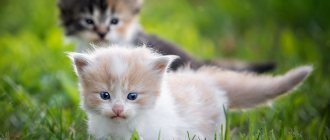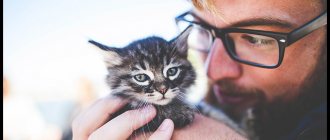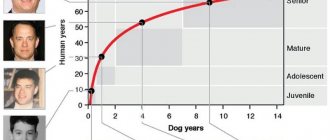Home » About cats » How to determine the age of a kitten
Even the tiniest kitten will never be happy without proper attention from its owner. For psychological balance, it is vital for a baby and an adult animal to be caressed and stroked, talk to them or simply call them by name, showing that they are not forgotten and are in the zone of your warm attention. Every day for at least a short period of time! Necessarily!
Most cats reward their owners handsomely for any signs of attention and pay them with the deepest devotion throughout their lives. But just petting your pet every day is not enough; you must provide him with hair care, good living conditions, and provide him with proper nutrition, according to his state of health and age.
How to find out the age of your purr? Let's look at the options.
Eyes
They open during the first two weeks of a kitten's life. At first, all kittens have blue eyes. Subsequently, the color of the kitten's iris usually begins to change. The age of small kittens can be approximately determined by their eyes:
- If they are still closed, then the kitten is no more than a week old;
- If the eyes are open but still narrow, he is 2-3 weeks old;
- If the iris of the eye begins to change color, the kitten is 6-7 weeks old.
Age: how to determine how many months?
It is quite difficult for many people to determine the age of someone else’s child by appearance; they can be mistaken by a couple of years, what can we say about a kitten that is rapidly growing up.
To approximately determine the number of months that have passed since the birth of a furry animal, you need to carefully familiarize yourself with the main stages of the formation of animals.
This information will help you find out your age with great accuracy. It is especially important to have this knowledge if you want to have a breeding animal in order to be guaranteed to acquire an individual of a certain age.
Based on the recommendations of the association of felinological clubs WCF, breeders try not to separate mother and kittens until they reach the age of 3 months. The emphasis is on the fact that during this time the young animal gains the required weight, is fully formed, and acquires social behavior skills.
But for an inexperienced buyer it is difficult to understand what is being offered to him: a mature animal or an overgrown animal, the price of which is much lower.
And buying a purebred animal abroad is another important point in which you need to know the age of the pet.
According to the rules governing the transportation of animals across the border, only a five-month-old animal can be legally brought into the country. If a seller offers to deliver a kitten from abroad whose appearance indicates that it is no more than three months old, there is obvious fraud.
Important! The ability to determine the age of a cat based on external signs will become a real defense against unscrupulous breeders.
It is believed that you can find out the approximate age of an animal:
- by weight and body size;
- by eye color;
- on the formation of teeth;
- by appearance;
- by behavior.
Be sure to read:
How cats are euthanized in veterinary clinics, can you do it yourself at home?
A newborn kitten looks like a small worm, the size of its body with pronounced color fluctuates around ten centimeters, it does not hear, does not see and is completely helpless.
But after five days, the first changes begin: the kitten develops hearing, the animal begins to react to external stimuli.
The kitten matures rapidly; by the age of three months, the process of formation into an adult is almost complete.
Determination by weight and size
The weight of a newborn animal on average fluctuates within one hundred grams, but this value is relative and is influenced by a number of factors:
- the number of kittens in the litter: the greater it is, the less the weight of each animal;
- condition of the cat during pregnancy: proper nutrition has a positive effect on the weight of babies;
- individual characteristics of each pet: a healthy kitten is born larger;
- gender: at birth, weight does not depend on the sex of the animal, but later cats begin to gain weight a little faster.
After birth, babies begin to rapidly gain weight; during the first week, the seals should become 6-15 grams heavier for each day they live; after two weeks, the weight of the animals approximately doubles.
After birth, babies begin to rapidly gain weight
Subsequently, weight gain does not occur as intensively; by the age of five months, kittens should gain an average of 100 grams in seven days.
After six months, the animal’s growth practically ends, and weight gain begins to occur only due to further muscle formation and strengthening of the skeleton.
An adult is considered an animal that has gone through puberty, which occurs (depending on the breed) at one and a half to two years.
The approximate ratio of height and weight is given in the table:
Determining age based on the animal’s body weight is quite difficult: all the values given in various tables have a lot of differences. Based on the data from the tables, only one thing can be determined with accuracy - whether the pet is healthy and whether it needs additional feeding.
For the same reasons, it is difficult to accurately determine the age of a pet based on its size. Even a number of standards established for purebred cats allow for a wide range of values in the size of animals, let alone mongrel kittens.
Without knowing in advance what size a small predator picked up on the street is going to grow to, it is difficult to understand how many months old it is at the moment.
Naturally, kittens of miniature and large breeds can only be compared at birth; newborn babies are approximately the same in size. Then the differences begin - large cats grow much faster than individuals of miniature breeds, the difference in size becomes especially noticeable after 4 weeks
Be sure to read:
How much does a cat weigh: table by age and breed, assessment, deficiency, norm and excess
The weight and size of a pet are far from the most accurate parameters for determining age.
Identification by eyes
All kittens are born blind.
The eyes of a small predator are a fairly accurate marker for determining the number of days lived:
- if the baby's eyes are tightly closed, he is not even a week old;
- if slits appear on the eyes, he is about 7-9 days old;
- If they open completely, the cat is 2 weeks old.
After three weeks, changes in the color of the iris begin, because initially the eyes of all kittens are a dull blue color; the eyes acquire a permanent color at the end of the second month of life.
Determination by teeth
A newborn baby has no teeth in its mouth, therefore, by the fangs and incisors that appear in its small mouth, you can find out the age of the animal.
A newborn baby has no teeth in its mouth
In furry predators, teeth are formed in 2 stages: first, milk teeth are cut, later they are replaced by molars (permanent) teeth.
Determination by teeth occurs according to the following scheme:
- In the first 14 days, teeth on the jaws are completely absent.
- By the end of the third week, the front incisors appear.
- By the end of the fourth week, the two upper and two lower canines begin to grow.
- At about seven weeks of age, the little predator grows molars (the far side teeth) and premolars (located between the fangs and molars).
- By eight weeks, the animal can count 26 teeth (deciduous).
- By six months, baby teeth begin to change into permanent ones.
- By one year, an adult cat has a full set of teeth (30 pieces).
Determining the age limit based on your pet's teeth is the most accurate way.
According to the condition of the coat and skeleton
Another way to find out when a cat was born is to evaluate the condition of the fur. In small kittens, the undercoat is thicker to the touch; down hairs predominate in the fur, rather than guard hairs. The coarse, straight guard hairs are fully grown at around six to seven months.
The proportions of the small predator also indicate its age. Up to three months, kittens look disproportionate: they have a huge head, thin paws, and an impressive belly. But closer to the age of three months, the clumsy creature turns into a graceful beast with a well-formed skeleton and noticeable muscles.
Animal ears are another marker. A baby who has recently been born has soft ears, located on the sides of the head and almost pressed close to it.
The ear begins to form from the middle of the second week: the auricle gradually opens, and the ear takes the right place on the head of the predator. After six weeks, the ears become hard to the touch, but only by the age of three months are they finally formed, losing their childish roundness.
Be sure to read:
Cats in ancient Egypt: their meaning, features of appearance and character, education and training
Behavior and age
By observing the behavior of a furry fidget, you can roughly calculate its age. At the end of the second week, the baby begins to take his first steps on unruly paws.
At one month of age, the kitten begins to run, jump, and climb on various vertical surfaces.
The two-month-old animal begins to instinctively attack all moving objects, “hunting” them.
Determination method by puberty
The onset of puberty has a dramatic effect on your pet's behavior.
The first signs are noticeable already at the age of five months: the cat begins to meow loudly and tries to get out of the apartment.
By seven months, the animal may become aggressive, begin to attack its owners, and bite them, which indicates that the animal has acquired sexual maturity.
Baby teeth
Kittens have no teeth until they are two weeks old. All baby teeth should appear before eight weeks.
- The first of the baby teeth to emerge are the incisors. As a rule, this occurs by the third week;
- Fangs appear at 3–4 weeks;
- Premolars, that is, teeth located after the canines, appear at 1–2 months. On the upper jaw, cats should have three premolars on each side, on the lower jaw - two.
At two months, a kitten should have 26 teeth: 12 incisors, 4 canines and 10 premolars.
Definition of puberty
Puberty of pets makes adjustments to their habits. This is typical for 5-7 month old individuals. The cat makes loud noises, attracting females, asks to go for a walk, marks its territory, and sniffs cats. His urine takes on a strong, unpleasant odor. Can tear wallpaper and furniture. Excessive playfulness disappears. Some males show interest in the opposite sex when they are a year and a half old.
Signs of hormonal changes in a cat:
- intensely shows a desire to be caressed;
- rubs against legs, against interior items;
- a small amount of mucus is released from the genitals (estrus);
- meows invitingly, rolling on the floor;
- lifts tail, demonstrating desire to mate.
Under the influence of hormones, cats can behave aggressively (biting, scratching). It is worth accepting this behavior patiently in order to calmly wait out the hormonal surge. Pedigree cats mature later than outbred cats, which is confirmed by the behavior of their pets.
Example of Scottish kittens
Normal six months is about three kilograms. The optimal weight allowed for an adult cat is six and a half kilograms. Typically an adult cat weighs four and a half kilograms. If the weight is greater, this means that the pet is overfed. Scottish cats should not be allowed to overeat. This is very harmful to the pet's health.
From the age of four months, a Scottish kitten already outweighs kittens of the same age from other breeds in weight. Already at seven months, cats turn into five-kilogram animals. And at nine months, even cats gain more than four kilograms in weight.
Animals can constantly ask for treats, but frivolous indulgence of an insatiable appetite is dangerous to their health.
Who can confirm our assumptions?
If you are not an expert, or at least have not had cats in your home before, it is very important to verify your assumptions about the age of your pet.
There are two ways out:
- Contact the breeder
The former owner or breeder has been watching your new friend since his birth.
Therefore, the first owner will probably advise you accurately at the age of the kitten.
However, what to do if your pet is found on the street?
- Let's go to the veterinarian
Of course, it is an experienced specialist, and especially a specialist in small animals, who can easily but accurately tell you the age period of a young four-legged pet.
In addition, even if you have dealt with cats before, the help of a veterinarian can never be superfluous.
Sexual characteristics appear in cats from birth.
Signs
So, let's say you adopted a pet from the street and want to know more about it. How to determine the age of a kitten at home ? Most often, five features are distinguished:
- the size of the animal and its physique;
- ears and eye shade;
- weight;
- teeth;
- the way he behaves.
It is necessary to consider in detail all the signs listed above in order to understand how to determine the age of a kitten .
Weight
After birth, the animal grows very quickly and gains weight, so this also becomes a defining feature.
Naturally, if you brought a new pet from the street, it will weigh less than a pet, so initially it needs to be fed strictly on time and in the prescribed portions. By eating normally, he will gain 10-30 grams of weight every day.
Some factors influence weight:
- maternal nutrition during pregnancy;
- number of kittens in the litter;
- genetic factors;
- gender of the animal.
How to determine a kitten's age by weight:
- Week – 80-125 grams.
- 15 days – 120-170 grams.
- Three weeks - up to 260 grams.
- Month – 350-550 grams.
- Five to seven weeks – 480-760 grams.
- More than two months – 800-1300 grams.
- 12 weeks – 1300-1500 grams.
- Three months – 1800-2300 grams.
- An adult animal is 4-5 kilograms.
Behavior and activity
If the kittens are close to the mother cat, then at 7 weeks she stops feeding them, and the two-month-old cubs themselves leave her to explore the world around them. In general, the age of babies can be determined by the way they move:
- crawl – up to 2 weeks;
- begin to walk, unsteadily, at 2 weeks;
- stand firmly on their paws - at 3 weeks;
- move quickly and confidently, try to play - at 4 weeks;
- can run, show curiosity - at 5 weeks;
- become confident and mobile - at 1.5 months.
A two-month-old cub develops good coordination, becomes bolder, ceases to be afraid of others and even tries to flirt with them. The kitten moves a lot, loves to play with people and other pets, gets into all available places and climbs or jumps there.
Useful tips
A baby’s memory works best when remembering from two to seven weeks. This period is the best for socialization.
If the pet quickly overcomes fear and willingly goes into your arms, then most likely it is no more than two months old.
It is necessary to actively accustom the kitten to holding hands, talk to it affectionately, and play a lot. But even if the pet is clearly older and continues to run wild, do not despair, love and patience can break the stereotype of a cat’s behavior, no matter what age he is.
If the gender of the kitten is unknown, then it is quite easy to determine it from the age of two weeks. The male's genitals resemble a colon, while the female's have a question mark.
As they grow older, secondary sexual characteristics (size, weight, build) become more obvious.











